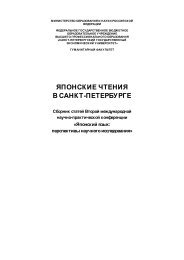to Learners with Special Educational Needs
e-textbook SEN
e-textbook SEN
You also want an ePaper? Increase the reach of your titles
YUMPU automatically turns print PDFs into web optimized ePapers that Google loves.
Pokrivčáková, S. et al. (2015). Teaching Foreign Languages <strong>to</strong> <strong>Learners</strong> <strong>with</strong> <strong>Special</strong> <strong>Educational</strong> <strong>Needs</strong>:<br />
e-textbook for foreign language teachers. Nitra: Constantine the Philosopher University. 128 p.<br />
ISBN 978-80-558-0941-0<br />
9 Teaching English <strong>to</strong> gifted children<br />
Eva Reid<br />
DOI: 10.17846/SEN.2015.115-123<br />
Objectives<br />
This chapter provides a brief description of characteristics and peculiarities of gifted children<br />
and gifted education. There are two forms of educating gifted children: integrated in regular<br />
classes and segregated in special classes. There are certain tips concerning working <strong>with</strong> gifted<br />
children, what <strong>to</strong> do and what <strong>to</strong> avoid. Teaching English as a foreign language <strong>to</strong> gifted children<br />
also has its specifics and these are discussed, <strong>to</strong>gether <strong>with</strong> general tips, in this chapter.<br />
Defining giftedness and identification characteristics<br />
Silverman (2012) views giftedness as a psychological reality, which can be observed in young<br />
children and documented on measures of general intelligence.<br />
Characteristics such as abstract thought, insightfulness, compassion, sensitivity,<br />
perfectionism, intensity, creative imagination, sophisticated sense of humour accompany gifted<br />
individuals throughout their lives. Giftedness needs early identification, intervention and<br />
accommodation <strong>to</strong> assure healthy development.<br />
There is a common belief that gifted children make it on their own, that they do well by<br />
themselves <strong>with</strong>out any special intervention. However, it is a myth, which should be avoided, as<br />
Silverman (ibid.) pointed out that most gifted children hide or underachieve. Jurašková (2003)<br />
added that gifted children do not develop their talents <strong>with</strong>out the support of schools, families<br />
and society, because they stand out from average population in cognitive and emotional areas.<br />
According <strong>to</strong> Dočkal (1995, 2005) development of talent depends on the environment. The more<br />
stimulating the environment is, the higher is the chance of development of a talent. Renzulli<br />
(2011), one of the greatest scholars on gifted education, emphasised the necessity of special<br />
education for gifted children, as they exhibit specific needs. This idea is also supported by<br />
Milgram (1991) who claimed that gifted children cannot maximize their abilities in regular<br />
school programmes unless teaching is adjusted <strong>to</strong> their specific needs. According NAGC (2014),<br />
separate studies done in the last decades prove the need for gifted education and more<br />
importantly the benefits of special education of the gifted children. Very eloquent is an analogy<br />
is <strong>with</strong> developing sports talents. Even the greatest sportsmen would not have been so great if<br />
their specific talents had not been developed by specially trained coaches. In comparison, how<br />
do we expect gifted children <strong>to</strong> train themselves <strong>to</strong> be outstanding in science, languages, etc. if<br />
we do not develop their talents? As a result, we need special education for gifted children <strong>with</strong><br />
special approach in order <strong>to</strong> develop their abilities <strong>to</strong> maximum.<br />
Many gifted education programs around the world set as a minimum criterion an IQ score of<br />
130 for admitting children <strong>to</strong> their special programs. Gifted individuals are further divided based<br />
on the IQ scored they achieve (Wasserman, 2003). Lazniba<strong>to</strong>va (2007, 2012) adds that every<br />
gifted individual is unique and the population of the gifted does not form a homogenous group.<br />
Gifted individuals are a diverse group <strong>with</strong> various foundations and conditions for development.<br />
This diversity influences the process of development, which emerges in various levels and areas<br />
of giftedness. Even though the gifted children are a heterogeneous group, there are certain<br />
identification characteristics, which can apply <strong>to</strong> diverse socio-economic and cultural<br />
backgrounds. It is not a simple task <strong>to</strong> identify gifted children, as many are hidden, or do not<br />
exhibit their talents. These are some of the common identification characteristics of gifted<br />
children (Lazniba<strong>to</strong>vá, 1996, 1998, 2001, 2008; Dočkal, 2005; Silverman, 2012):<br />
excellent memory,<br />
good reasoning,<br />
115






